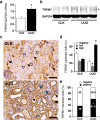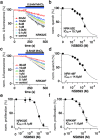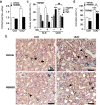TRPM7 contributes to progressive nephropathy
- PMID: 32047249
- PMCID: PMC7012919
- DOI: 10.1038/s41598-020-59355-y
TRPM7 contributes to progressive nephropathy
Abstract
TRPM7 belongs to the Transient Receptor Potential Melastatin family of ion channels and is a divalent cation-conducting ion channel fused with a functional kinase. TRPM7 plays a key role in a variety of diseases, including neuronal death in ischemia, cancer, cardiac atrial fibrillation, malaria invasion. TRPM7 is aberrantly over-expressed in lung, liver and heart fibrosis. It is also overexpressed after renal ischemia-reperfusion, an event that induces kidney injury and fibrosis. However, the role of TRPM7 in kidney fibrosis is unclear. Using the unilateral ureteral obstruction (UUO) mouse model, we examined whether TRPM7 contributes to progressive renal damage and fibrosis. We find that TRPM7 expression increases in UUO kidneys. Systemic application of NS8593, a known TRPM7 inhibitor, prevents kidney atrophy in UUO kidneys, retains tubular formation, and reduces TRPM7 expression to normal levels. Cell proliferation of both tubular epithelial cells and interstitial cells is reduced by NS8593 treatment in UUO kidneys, as are TGF-β1/Smad signaling events. We conclude that TRPM7 is upregulated during inflammatory renal damage and propose that pharmacological intervention targeting TRPM7 may prove protective in progressive kidney fibrosis.
Conflict of interest statement
The authors declare no competing interests.
Figures








References
-
- Trapani V, Arduini D, Cittadini A, Wolf FI. From magnesium to magnesium transporters in cancer: TRPM7, a novel signature in tumour development. Magnes. Res. 2013;26:149–155. - PubMed
Publication types
MeSH terms
Substances
LinkOut - more resources
Full Text Sources
Medical
Miscellaneous

